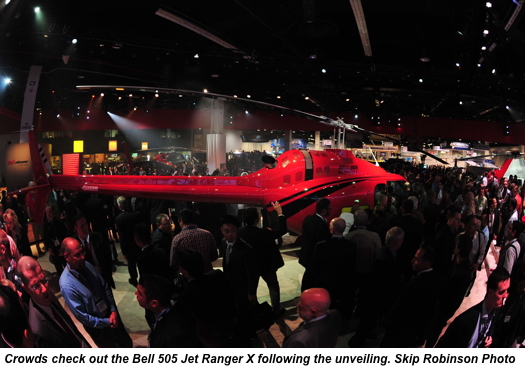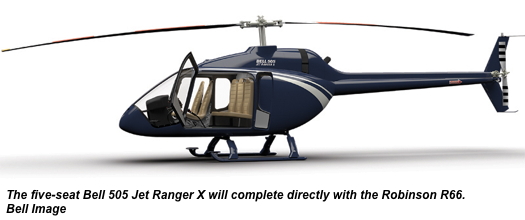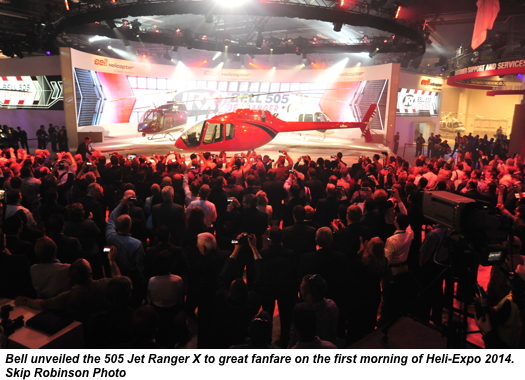At Heli-Expo 2012 in Dallas, Texas, Bell Helicopter spared no expense in unveiling its first new medium product in years, the Bell 525 Relentless. The video, smoke, and light show associated with the unveiling was so over-the-top, it was repeated by popular demand the following day — and drew just as large of a crowd, even though the element of surprise was gone. Since then, the company’s video of the event on YouTube has received more than 55,000 views, which may well be a record for a helicopter trade show presentation.

Bell has attempted to recapture that magic at Heli-Expo 2014 with the equally dramatic unveiling of its new short light single product, the Bell 505 Jet Ranger X. Here, the only real element of surprise is the name, since the company revealed the concept at the 2013 Paris Air Show in June under the “Bell SLS (Short Light Single)” designation. Nevertheless, in the run-up to Heli-Expo, Bell expected the unveiling to make as big of an impact as the Relentless introduction did. “We’re looking to shock the crowd and bring tears of joy to the eyes of anyone who is associated with Bell products,” director of Marketing and Sales Support Chuck Evans told Vertical.
Bell has certainly been able to top the Relentless unveiling in one respect: thanks to the relative sizes of the aircraft (the Jet Ranger X has five seats to the Relentless’ 18-plus), there are three of the new 505 helicopters on display, rather than one. The centerpiece of the display is a model that is representative of the baseline configuration, and it incorporates a number of actual components, including real main and tail rotors, and a functioning drive system that borrows from Bell’s existing 206L4 LongRanger, as it will on the real thing. The display model also features the 504-shaft horsepower Turbomeca Arrius 2R engine that will power the production aircraft (and which will include a dual-channel full authority digital engine control, or FADEC). “Some folks will be convinced that the mockup is a real, flying aircraft,’” said Evans. “In reality, it has served a dual purpose as a mockup and a platform for fast prototyping of some components.”

The other models on display aren’t quite as close to the real thing, but they should still give prospective customers a good idea of what to expect from the aircraft. One of the models is in a light law enforcement configuration, incorporating a SpectroLab SX-7 searchlight, FLIR Ultra 8500 infrared camera system, and tactical flight officer station. The third model is representative of a corporate configuration, with a paint scheme and interior that are intended to spark interest among private owners.
With the Jet Ranger X, Bell is taking square aim at the five-seat Robinson R66 Turbine, which has come to dominate the light turbine helicopter market since Bell ceased production of the 206B3 JetRanger in 2010. Even without European Aviation Safety Agency certification for the R66 (or, until recently, certification for the model in Canada and Russia), Robinson produced 191 R66 helicopters in 2012, and 192 of them in 2013. Clearly, worldwide demand for this US$839,000, five-seat helicopter is strong, and Bell believes it can compete with it. The company will begin taking orders for the Jet Ranger X at Heli-Expo 2014, and while Bell has not yet announced a price for the aircraft, it promises that the 505 “will be price-competitive with the current class-leader,” said Evans.
Bell also has yet to announce precise performance specifications for the aircraft, beyond its targets for a 1,500-pound (608-kilogram) useful load, 125-knot (232-kilometer/hour) cruise speed, and 360- to 420-nautical mile (667-km) range — which the company said were recommended by a diverse customer advisory council. With luck, however, these specifications will be firming up soon. “We’ve made incredibly quick progress on this aircraft,” said Evans, who confirmed that the company is still aiming for first flight by the end of 2014, and certification “as soon as possible after that.”

Meanwhile, construction will commence on a new 82,300-square-foot, $26.3 million assembly facility for the Jet Ranger X in Lafayette, La. Bell announced in December that the state of Louisiana would be funding the construction of the facility, which will be owned by Lafayette Regional Airport and built on a 14.5-acre site there. Louisiana is also offering Bell a competitive incentive package that includes performance-based grants of $4.0 million for lease support, $3.8 million for infrastructure and equipment, and $200,000 to reimburse relocation expenses. Even with Louisiana sweetening the pot, some questioned why Bell would want to start up a new commercial production facility, rather than building on existing efficiencies at its primary commercial production facility in Mirabel, Que. But Evans told Vertical that Mirabel is “a very busy facility and they really don’t have the space right now to accommodate the program.” Lafayette, on the other hand, promised plenty of space, along with the skilled workforce that has developed around the region’s offshore oil-and-gas industry.
Speaking of that oil-and-gas industry, the 525 Relentless mockup that was unveiled at Heli-Expo 2012 in the livery of Lafayette-based operator PHI, Inc. is back at the show this year, but sporting a new paint scheme. Now, it’s decked out in red, white, and black — “a representative coast guard livery,” according to Evans. With dual hoists, a hoist operator’s station, and dual litters, the model is intended to show off the aircraft’s potential as a search-and-rescue platform as well as an offshore people mover. Evans said the Relentless program is “still on track to perform its first flight by the end of the year,” with no new updates on timing to report. The first test vehicle is now in production, and Bell has already performed the first “flight” of “Aircraft Zero” — a systems integration lab that operates fully integrated Bell 525 systems, including flight controls, software, hydraulics, actuators, electrical and avionics. “It’s a validation of the fly-by-wire controls,” Evans said, explaining that the systems integration lab is allowing the company to mature the flight control system before moving on to the real thing.
Rounding out the Bell exhibit in Anaheim are two more of the company’s cutting-edge products: the 429WLG and the 407GX. In January, Bell announced that it had achieved initial certification from Transport Canada and the National Civil Aviation Agency of Brazil for the 429WLG, the wheeled version of the company’s popular Bell 429 helicopter. Evans said the company has been taking orders for the aircraft, many of them from the corporate sector, where the aircraft’s ability to taxi closer to fixed-base operators is a particularly strong selling point. However, the wheeled landing gear does add around 250 pounds to the model — which is more of an issue for prospective buyers outside of Canada and the 17 countries that have followed Transport Canada’s lead in approving a 500-pound maximum gross weight increase for the 429. In the United States, Bell has not made significant headway on the matter since the Federal Aviation Administration denied its request for the weight exemption in 2012, and Bell appealed the denial. However, “We remain very optimistic that we will get the aircraft certified at 7,500 pounds maximum gross weight,” Evans said.
Meanwhile, sales of the 407GX — which upgrades the Bell 407 with a Garmin G1000H with a glass-panel flight deck and additional safety-enhancing technologies — have outpaced sales of the baseline model. “The 407GX is really the best seller of the two products,” said Evans. “It comes back to that mantra of safety . . . It’s clear that the market places high value on improving safety.” Evans said that Bell is seeing international interest for the 407GX, as it is for another model that is missing from the booth this year — the 412EPI. That upgraded version of the Bell 412 is currently performing flight demonstrations in the Asia-Pacific region, which is one of the international markets where Bell is seeing the most potential for the aircraft. “The international interest for the 412 has changed with the introduction of the EPI,” Evans said. “It’s not as centered in North and South America as it was.”









